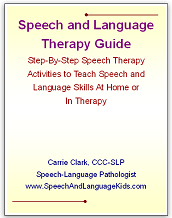Sign Up For Our E-Blast To Receive Information on our Books, Speech Therapy materials and our latest freebies!
A Speech Therapy Guide for Parents and SLPs!
A Speech Therapy Guide for Parents and SLPs!
A few months ago, fellow speech language pathologist (SLP), Carrie Clark and creator of Speech and Language Kids, gave me a copy of her awesome e-book:
Speech and Language Therapy Guide Step-by-Step Speech Therapy Activities to Teach Speech and Language Skills At Home or In Therapy
This e-book is very comprehensive and a wonderful back to school purchase for either SLPs or parents of young children.
There is A LOT of information in this colorful activity guide. In fact there are 554 pages of information that include 6 Different Step-By-Step Guides to target the following:
- Early Communication Skills
- Vocabulary
- Grammar
- Questions
- Speech Sounds
- Social Skills
Since this guide is so inclusive, I’m going to focus on my favorite part:
Her Grammar Guide!
Carrie’s Grammar Guide inspired me to write about the Possessive –s, a few posts back. Click on the picture below to read more:
Carrie’s Grammar Guide is approximately 75 pages and includes step by step instructions along with digital pictures to instruct how to teach a child to use:
- The possessive –s
- The plural –s
- Irregular plurals
- The present progressive “ing”
- The pronouns “he” and “she”
- The past tense verbs
- Articles (the, a, and an)
- The conjunction “and”
- Increase a child’s length of utterance
I particularly like Carrie’s Grammar Guide because she includes ALL of the following for EACH concept:
A rationale – she explains WHY we need to address a particular skill. For instance, for the present progressive –ing, Carrie provides the following rationale:
“The present progressive “-ing” grammatical marker is the one we tack on the end of a verb to say that the action is currently happening. For example, we might say “he is running” or “she is flying”. When a child does not use the “-ing” ending on present progressive verbs, it can be hard for the listenerto determine the exact meaning of the sentence and can make the child’s speech sound telegraphic or choppy.”
Age of Mastery – when the skill is mastered by most children. Once again, here’s an example from her present progressive-ing worksheets:
“A child should be using the present progressive “-ing” by two and a half years. However, keep in mind that there is a wide range of normal so some children may learn it earlier and some later, but that’s a good general age.”
Learning Steps – where to start with a particular skill and where to go next. For instance, with the present progressive-ing, Carrie progresses you
from “-ing” in single words
to “-ing” in sentences
to“-ing in conversation
Sample IEP Goals (how super super helpful!)
- “By <Date>, Child will use the present progressive “-ing” in single words when answering thequestion “what is __ doing?” on 4 of 5 observed opportunities on 3 consecutive data collection days.”
- “By <Date>, Child will use the present progressive “-ing” in sentences when describing pictureson 4 of 5 observed opportunities on 3 consecutive data collection days.”
- “By <Date>, Child will use the present progressive “-ing” during 5 minutes of conversational speech on 80% of observed opportunities on 3 consecutive data collection days.””
Carrie also includes data collection tables (we, SLPs, LOVE tracking data!) which are always helpful to assess progress.
Here’s a quick peek at one of her worksheets:
So, where can you buy Carrie’s Speech and Language Therapy Guide?
It’s available for purchase on her website.
Click on here to check it out and see her youtube video!!
Thank you, Carrie for the opportunity to review your product!
Kimberly Scanlon, M.A. CCC-SLP is a speech language pathologist, an author and a mother. As the owner of Scanlon Speech Therapy, LLC, a unique boutique practice in Bergen County, Kimberly embraces individuality and treats the whole person. Her goal is to spread compassion, hope, and some speech, language and literacy tips one moment, one person at a time. Her first book, My Toddler Talks: Strategies and Activities to Promote Your Child’s Language Development and her her second book, Learning to Read is a Ball
are available for purchase at online at Amazon and Barnes and Noble.



